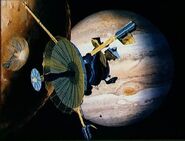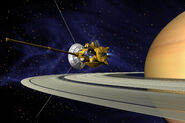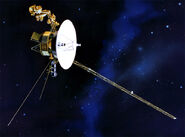A spacecraft is a vehicle designed for travel or operation in space beyond the Earth's atmosphere or in orbit around the Earth.[1]
Types[]
A spacecraft is any piloted or unpiloted vehicle designed for travel in space. The systems and instruments a spacecraft must carry depends upon the data it will gather and the functions it will carry out. Their complexity varies greatly but all must endure the hostile environment of space. Spacecraft may be broadly categorized according to the missions they are intended to fly.[2]
- Manned spacecraft: A piloted spacecraft designed to carry astronauts into space. Unlike an unmanned probe, it requires a crew compartment and life support systems. Manned spacecraft are either reusable, such as the Space Shuttle, or designed for one time use, such as Soyuz. The latter type is generally modular, such as consisting of a reentry module which houses the crew and a service module which contains propulsion, power supply and life support. Only the reentry module returns to Earth.
- Flyby spacecraft: A spacecraft which follows a continuous trajectory past a target object, never to be captured into an orbit. It must carry instruments that are capable of observing passing targets by compensating for the target's apparent motion. The spacecraft must be able to survive long periods of interplanetary cruise and must be able to downlink data at high rates. Examples of flyby spacecraft include Pioneers 10 and 11, and Voyagers 1 and 2.
- Orbiter spacecraft: A spacecraft designed to travel to a distant planet or moon and enter orbit. It must carry a substantial propulsive capability to decelerate it at the right moment to achieve orbit insertion. An orbiter spacecraft must endure periods during which it is shaded from sunlight, thus it must be resistant to extreme thermal variation and will require power storage capacity if equipped with solar panels. Examples of orbiter spacecraft include Magellan, Galileo and Mars Global Surveyor.
- Atmospheric probe: A small instrumented craft which separates from the main spacecraft prior to closest approach to a planet to study the gaseous atmosphere of the body as it drops through it. It is equipped with an aeroshell to protect it during atmospheric entry and a parachute to slow its decent. Data is typically telemetered to the mother craft where it is recorded for later transmission to Earth.
- Atmospheric balloon package: An instrumented package suspended from a buoyant gas bag, deployed in a planet's atmosphere to study wind circulation patterns. It has a limited complement of spacecraft systems aboard. The minimum requirements include a power supply and telecommunications equipment to permit tracking.
- Lander spacecraft: A spacecraft designed to reach the surface of a planet or moon and survive long enough to telemeter data back to Earth. It may perform a powered descent and landing or may descend to the surface suspended from a parachute. Examples of lander spacecraft include Surveyor, Viking, Mars Pathfinder and the Soviet Venera.
- Surface penetrator: A probe designed to penetrate the surface of a body, surviving an impact of hundreds of g's, measuring and telemetering the properties of the penetrated surface. Data is typically telemetered to the mother craft for re-transmission to Earth. The Mars Polar Lander will deploy two penetrators upon its arrival at Mars.
- Surface rover: A semi-autonomous roving vehicle, steerable from Earth, deployed on the surface of a planet or other body, taking images and soil analyses for telemetering back to Earth. The Mars Pathfinder mission included a solar-powered, wheeled microrover named Sojourner.
References[]
- ↑ Define spacecraft from Dictionary.
- ↑ Spacecraft Systems


